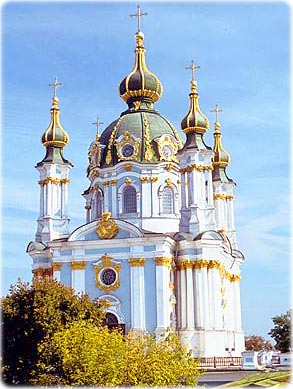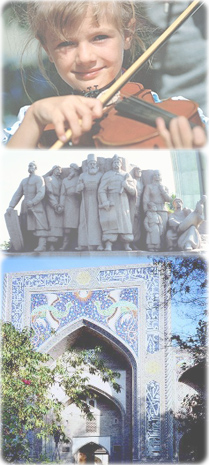
Ukraine

Central square of Kiev, Ukraine.
|
◄ Europe |

Geography
Administrative divisions: 24 oblasti (singular - oblast'), 1 autonomous republic (avtomnaya respublika), and 2 municipalities (mista, singular - misto) with oblast status.
Total area: 603,700 km², the second-largest country in Europe. Coastline: 2,782 km.
Terrain: most of Ukraine consists of fertile plains (steppes) and plateaus, mountains being found only in the west (the Carpathians), and in the Crimean Peninsula in the extreme south. Highest point: Hora Hoverla 2,061 m.
Climate: temperate continental; Mediterranean only on the southern Crimean coast; precipitation disproportionately distributed, highest in west and north, lesser in east and southeast; winters vary from cool along the Black Sea to cold farther inland; summers are warm across the greater part of the country, hot in the south.
Ports and harbors: Berdyans'k, Feodosiya, Illichivs'k, Izmayil, Kerch, Kherson, Kiev (Kyiv), Kiliya, Mariupol', Mykolayiv, Odesa, Reni, Sevastopol', Yalta, Yuzhnyy.
People
Population: 44 million (2018).
Religions: Orthodox (includes Ukrainian Autocephalous Orthodox (UAOC), Ukrainian Orthodox - Kyiv Patriarchate (UOC-KP), Ukrainian Orthodox - Moscow Patriarchate (UOC-MP)), Ukrainian Greek Catholic, Roman Catholic, Protestant, Muslim, Jewish (2013 est.).
Ethnic groups: Ukrainian 77.8%, Russian 17.3%, Belarusian 0.6%, Moldovan 0.5%, Crimean Tatar 0.5%, Bulgarian 0.4%, Hungarian 0.3%, Romanian 0.3%, Polish 0.3%, Jewish 0.2%, other 1.8% (2001 est.).
Languages: Ukrainian (official) 67.5%, Russian (regional language) 29.6%, other (includes small Crimean Tatar-, Moldovan/Romanian-, and Hungarian-speaking minorities) 2.9% (2001 est.).
Main source: CIA - The World Factbook.
The Cathedral of St. Alexander Nevsky, in Yalta, Crimea. Its construction started in 1891 and the temple opened in 1902.

Andriyivska Church (St. Andrew's Cathedral) in Kiev.

Ukraine was the center of the first Slavic state, Kievan Rus, which during the 10th and 11th centuries was the largest and most powerful state in Europe. Weakened by internecine quarrels and Mongol invasions, Kievan Rus was incorporated into the Grand Duchy of Lithuania.
The cultural and religious legacy of Kievan Rus laid the foundation for Ukrainian nationalism through subsequent centuries. A new Ukrainian state, the Cossack Hetmanate, was established during the mid-17th century.
During the latter part of the 18th century, most Ukrainian territory was absorbed by the Russian Empire. Following the collapse of czarist Russia in 1917, Ukraine was able to bring about a short-lived period of independence (1917-1920), but was reconquered. Independence was achieved in 1991 with the dissolution of the Soviet Union. The capital is Kiev.
|
Copyright © Geographic Guide - Travel European Continent. |
Ukraine

Olga Demchishina